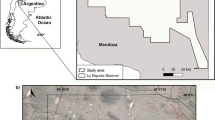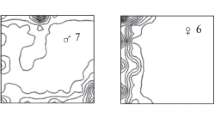Summary
Ecological and temporal aspects of the occurrence and dispersion patterns in three reed warbler species were examined. This provided insight into their intra-and interspecific territoriality. Seasonal changes in the occurrence of territorial males in a reed bed along a gradient from the shore landward were studied. The results demonstrate that intra- and interspecific spacing depends on interspecific dominance and/or ecological constraints. In this case it was shown that there is competition for common habitats between reed warblers and great reed warblers, whereas the moustached warbler is ecologically segregated. The reasons for these dispersal patterns are discussed. They do not appear to enhance the availability of food resources. It seems more likely that territorial spacing might function to reduce nest predation.
Similar content being viewed by others
References
Beier J (1981) Untersuchungen an Drossel- und Teichrohrsänger (Acrocephalus arundinaceus, A. scirpaceus): Bestandsentwick-lung, Brutbiologie, Ökologie. J Ornithol 122:209–230
Borowiec M (1983) Study on colour ringed breeding population of reed warblers (Acrocephalus scirpaceus) at Milicz fish-ponds. Dolina Baryczy 2:2–10
Brown JL, Orians GH (1970) Spacing patterns in mobile animals. Ann Rev Ecol Syst 1:239–320
Burger J (1985) Habitat selection in temperate marsh-nesting birds. In: Cody M (ed) Habitat Selection in Birds, Academic Press Inc NY, pp 253–281
Bussmann CH (1979) Ökologische Sonderung der Rohrsänger Südfrankreichs aufgrund von Nahrungsstudien. Vogelwarte 30:84–101
Catchpole CK (1972) A comperative study of territory in the reed warbler (Acrocephalus scirpaceus) and sedge warbler (Acrocephalus schoenobaenus). J Zool (Lond) 166:213–231
Catchpole CK (1973) The functions of advertising song in the Sedge warbler (Acrocephalus schoenobaenus) and the reed warbler (A. scirpaceus). Behaviour 46:300–320
Catchpole CK (1977) Aggressive responses of male sedge warbler (Acrocephalus schoenobaenus) to playback of species song and sympatric species song before and after pairing. Anim Behav 25:489–496
Catchpole CK,(1978) Interspecific territorialism and competition inAcrocephalus warblers as revealted by playback experiments in areas of sympatry and allopatry. Anim Behav 26:1072–1080
Catchpole CK (1983) Variation in the song of the great reed warbler (Acrocephalus arundinaceus) in relation to mate attraction and territorial defence. Anim Behav 31:1217–1225
Catchpole CK, Leisler B (1986) Interspecific territorialism in reed warblers: a local effect revealed by playback experiments. Anim Behav 34:299–300
Cody ML (1973) Character convergence. Annu Rev Ecol Syst 4:189–221
Crook JH (1964) The evolution of social organization and visual communication in the weaver birds (Ploceinae). Behaviour Suppl. 10:1–178
Darling FF (1938) Bird flocks and the breeding cycle. Cambridge Univ. Press, Cambridge
Dorsch H, Dorsch J (1985) Dynamik und Ökologie der Sommer-vogelgemeinschaft einer Verlandungzone bei Leibzig. Beitr Vogelk Jena 31:237–358
Dowsett-Lemaire F (1980) La territorialite chez la rousseroll verderolle,Acrocephalus palustris. Rev Ecol (Terre Vie) 34:46–67
Elliott JM (1971) Some methods for the statistical analysis of samples of benthic invertebrates. Scientific Publication No 25:148 p
Emlen ST, Oring LW (1977) Ecology, sexual selection, and the evolution of mating systems. Science 197:215–223
Gill FB, Wolf LL (1978) Comperative foraging efficiencies of some montane sunbirds in Kenya. Condor 80:391–400
Greenlaw JS (1988) On mating systems in passerine birds of american marshlands. Acta XIX Int Congr Ornithol II:2597–2612
Hoi H, Winkler H (1988) Feinddruck auf Schilfbrüter: Eine experimentelle Untersuchung. J Ornithol 129:439–447
Holt RD (1977) Predation, apparent competition, and the structure of prey communities. Theor Popul Biol 12:197–229
Johnson LK, Hubbell SP (1974) Aggression and competition among stingless bees: field studies. Ecology 55:120–127
Kelsey MG (1989) A comparison of the song and territorial behaviour of a long-distance migrant, the Marsh WarblerAcrocephalus palustris, in summer and winter. Ecology 131:403–414
Kluyver HN (1955) Das Verhalten des Drosselrohrsängers (Acrocephalus arundinaceus) am Brutplatz mit besonderer Berücksichtigung der Nestbautechnik und der Revierbehauptung. Ardea 43:1–50
Lack D (1966) Population studies of birds. Clarendon Press, Oxford
Lack D (1968) Ecological adaptations for breeding in birds. Methuen and Co. London
Lemaire F (1977) Mixed song, interspecific competition and hybridisation in the reed-and marsh warbler (Acrocephalus scirpaceus, A. palustris). Anim Behav 63:215–240
Leisler B (1981) Die ökologische Einnischung der mitteleuropäischen Rohrsänger (Acrocephalus, Sylviinae). I. Habitattrennung. Vogelwarte 31:45–74
Leisler B (1985) Öko-ethologische Vorraussetzungen für die Entwicklung von Polygamie bei Rohrsängern. J Ornithol 126:357–381
Leisler B (1988a) Interspecific Interactions among european marshnesting passerines. Acta XIX Intern Orn Congr Ottawa: 2635–2644
Leisler B (1988b) Intra- und interspezifische Aggression bei Schilf- und Seggenrohrsänger (Acrocephalus schoenobaenus, A. paludicola): Ein Fall von akustischer Verwechslung? Vogelwarte 34:281–290
MacArthur RH (1972) Geographical ecology. Harper and Row, New York
Martin TE (1988) Habitat and area effects on forest bird assemblages: is nest predation an influence? Ecology 69 (1):74–84
Moll KH (1958) Beobachtungen beim Bau des Teichrohrsängernestes. Falke 5:83–86
Morse DH (1970) Ecological aspects of some mixed-species foraging flocks of birds. Ecol Monogr 40:119–168
Morse DH (1971) Effects of the arrival of a new species upon habitats utilized by two forest thrushes in Maine. Wilson Bull 83:57–65
Morse DH (1977) Feeding behavior and predator avoidance in heterospecific groups. Bioscience 27:332–339
Morse DH (1980) Behavioral mechanisms in ecology. Harvard Univ. Press, Cambridge
Orians GH (1961) The ecology of blackbird (Agelaius) social systems. Ecol Monogr 31:285–312
Orians GH, Wilson MF (1964) Interspecific territories of birds. Ecology 45:736–745
Packard A (1972) Cephalopods and fish: the limits of convergence. Biol Rev 47:241–307
Pianka ER (1971) Lizard species diversity in the Kalahari Desert. Ecology 52:1024–1029
Picman J (1980) Impact of marsh wrens on reproductive strategy of red-winged blackbirds. Can J Zool 58:337–350
Picman J (1984) Experimental study on the role of intra- and interspecific competition in the evolution of nest-destroying behavior in Marsh Wrens. Can J Zool 62:2353–2356
Ricklefs RE (1989) Nest predation and the species diversity of birds. Trends Ecol Evol 4:184–186
Robertson RJ (1973) Optimal niche space of the redwinged blackbird: Spatial and temporal patterns of nesting activity and success. Ecology 54(5):1085–1093
Snow BL, Snow DW (1972) Feeding niches of hummingbirds in a Trinidad valley. J Am Ecol 41:471–485
Whittaker RH (1975) Communities and Ecosystems. MacMillan, New York
Wittenberger JF, Tilson RL (1980) The evolution of monogamy: Hypothesis and evidences. Annu Rev Ecol Syst 11:197–232
Yeaton RI, Cody ML (1974) Comparative release in island song sparrow populations. Theor Popul Biol 5:42–58
Author information
Authors and Affiliations
Rights and permissions
About this article
Cite this article
Hoi, H., Eichler, T. & Dittami, J. Territorial spacing and interspecific competition in three species of reed warblers. Oecologia 87, 443–448 (1991). https://doi.org/10.1007/BF00634604
Received:
Accepted:
Issue Date:
DOI: https://doi.org/10.1007/BF00634604




